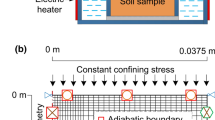Conclusions
-
1.
As a result of the investigations performed, the need for a complex approach to the study of thermal effects in rock is well founded, an approach which would permit the establishment of optimal regimes for thermal action for maximum strengthening of a rock mass.
-
2.
The maximum strengthening effect at T=550°C is attained without altering the crystal structure and is caused by the partial sintering of the particles because of a decrease in pore space, due to the removal of free and physically bound water as well as to the uniform grain size, i.e., the presence of a large amount of a finely dispersed clay fraction (38–77%).
-
3.
With thermal effects, the structural and textural features of the rocks must be considered, which will permit the determination of the expediency of their use in strengthening a rock mass.
Similar content being viewed by others
Literature Cited
A. V. Ralko, V. S. Gorodov, Yu. D. Zin'ko, and I. A. Kravtsov, Thermodynamic and Thermographic Studies of Heating Processes in Ceramics [in Russian], Vishcha Shkola, Kiev (1980).
V. P. Ivanova, B. K. Kasatov, T. N. Krasavina, and E. L. Rozinova, Thermal Analysis of Rocks and Minerals [in Russian], Nedra, Leningrad (1974).
B. M. Gumenskii, Principles of Physical Chemistry of Clay Soils and Their Use in Construction [in Russian], Stroiizdat, Leningrad, Moscow (1965).
Author information
Authors and Affiliations
Additional information
Translated from Fiziko-Tekhnicheskie Problemy Razrabotki Poleznykh Iskopaemykh, No. 5, pp. 38–42, September–October, 1984.
Rights and permissions
About this article
Cite this article
Shapar', A.G., Krasnopol'skii, I.A. & Khobotova, L.N. Patterns in the thermal stability of soils. Soviet Mining Science 20, 371–374 (1984). https://doi.org/10.1007/BF02498886
Received:
Published:
Issue Date:
DOI: https://doi.org/10.1007/BF02498886




